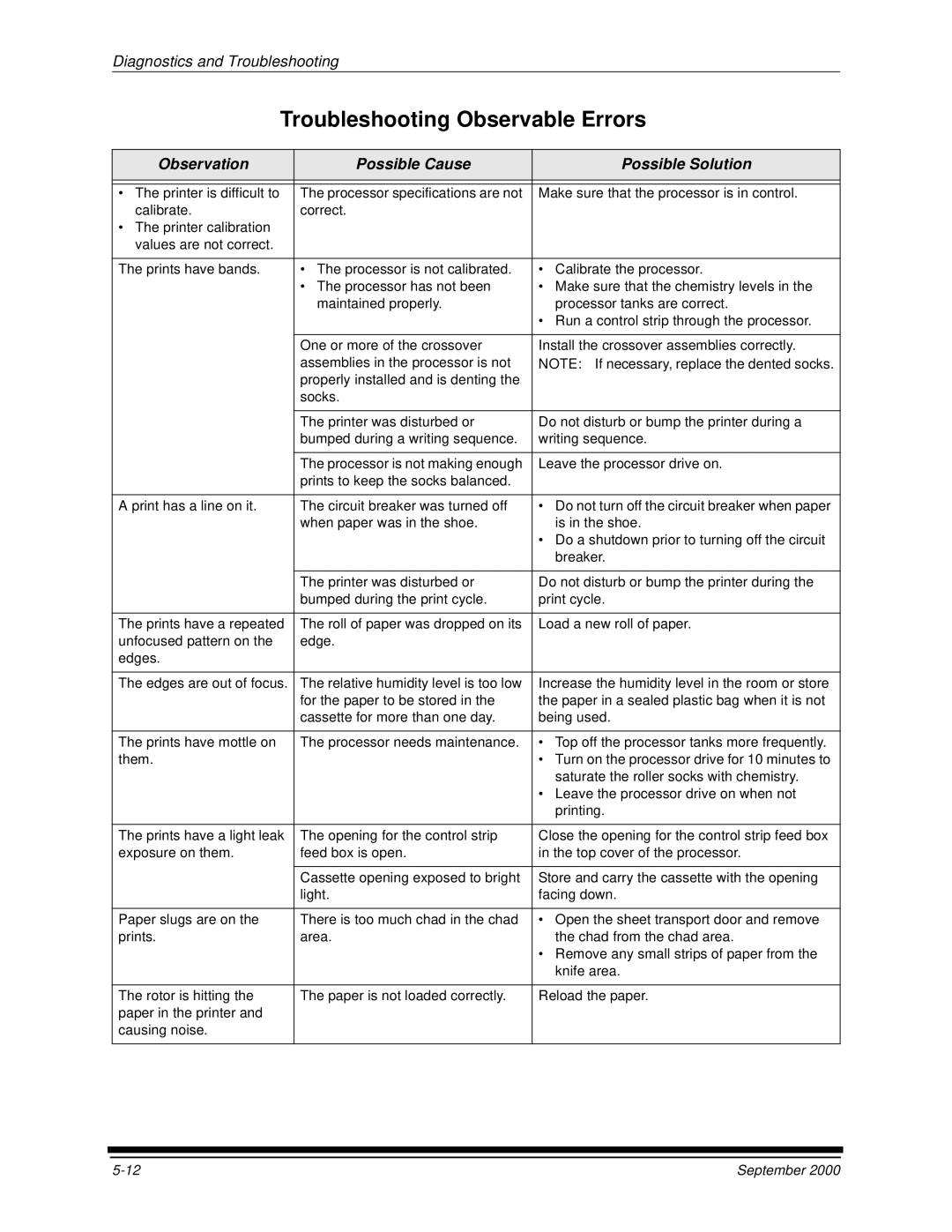
Diagnostics and Troubleshooting
Troubleshooting Observable Errors
Observation | Possible Cause | Possible Solution |
|
|
|
|
|
|
• The printer is difficult to | The processor specifications are not | Make sure that the processor is in control. |
calibrate. | correct. |
|
• The printer calibration |
|
|
values are not correct. |
|
|
|
|
|
The prints have bands. | • The processor is not calibrated. | • Calibrate the processor. |
| • The processor has not been | • Make sure that the chemistry levels in the |
| maintained properly. | processor tanks are correct. |
|
| • Run a control strip through the processor. |
|
|
|
| One or more of the crossover | Install the crossover assemblies correctly. |
| assemblies in the processor is not | NOTE: If necessary, replace the dented socks. |
| properly installed and is denting the |
|
| socks. |
|
|
|
|
| The printer was disturbed or | Do not disturb or bump the printer during a |
| bumped during a writing sequence. | writing sequence. |
|
|
|
| The processor is not making enough | Leave the processor drive on. |
| prints to keep the socks balanced. |
|
|
|
|
A print has a line on it. | The circuit breaker was turned off | • Do not turn off the circuit breaker when paper |
| when paper was in the shoe. | is in the shoe. |
|
| • Do a shutdown prior to turning off the circuit |
|
| breaker. |
|
|
|
| The printer was disturbed or | Do not disturb or bump the printer during the |
| bumped during the print cycle. | print cycle. |
|
|
|
The prints have a repeated | The roll of paper was dropped on its | Load a new roll of paper. |
unfocused pattern on the | edge. |
|
edges. |
|
|
|
|
|
The edges are out of focus. | The relative humidity level is too low | Increase the humidity level in the room or store |
| for the paper to be stored in the | the paper in a sealed plastic bag when it is not |
| cassette for more than one day. | being used. |
|
|
|
The prints have mottle on | The processor needs maintenance. | • Top off the processor tanks more frequently. |
them. |
| • Turn on the processor drive for 10 minutes to |
|
| saturate the roller socks with chemistry. |
|
| • Leave the processor drive on when not |
|
| printing. |
|
|
|
The prints have a light leak | The opening for the control strip | Close the opening for the control strip feed box |
exposure on them. | feed box is open. | in the top cover of the processor. |
|
|
|
| Cassette opening exposed to bright | Store and carry the cassette with the opening |
| light. | facing down. |
|
|
|
Paper slugs are on the | There is too much chad in the chad | • Open the sheet transport door and remove |
prints. | area. | the chad from the chad area. |
|
| • Remove any small strips of paper from the |
|
| knife area. |
|
|
|
The rotor is hitting the | The paper is not loaded correctly. | Reload the paper. |
paper in the printer and |
|
|
causing noise. |
|
|
|
|
|
September 2000 |
